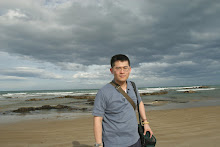At Flinders Blowhole, the coast feels ancient and untamed, a place where the continent seems to breathe through its fissures. Along the wild edge of Cape Schanck on the Mornington Peninsula, the sea is never still; it coils and uncoils in restless whirls, slipping into crevices and exploding upward in sudden white plumes. The rocks—dark, jagged, and uncompromising—stand like the exposed bones of the earth, their edges sharp-pointed and raw, shaped by millennia of wind, salt, and ceaseless surf.
In the golden hour, the landscape softens but never surrenders its power. Light pours over the volcanic basalt headlands, catching on each facet as though the cliffs were lit from within. The blowhole itself pulses with the tide, inhaling the ocean’s force and releasing it in rhythmic bursts, as if reciting a story older than language. Shadows lengthen across the headland, and the sky takes on that fleeting hue between fire and dusk—an amber wash that gilds the furious motion of the sea.
Cape Schanck’s natural history is written into every cliff line and cove. Formed from ancient volcanic activity, the peninsula’s southern tip bears the hallmark of its fiery origins: basalt columns, fractured plateaus, and boulders that seem to have been flung into place by some prehistoric force. Over thousands of years, wind and waves carved the coast into its present rugged form, sculpting the blowhole where the sea funnels through a narrow passage and erupts against the stone.
The surrounding scrublands—windswept coastal tea-tree, hardy grasses, and pockets of low heath—cling to the slopes with stubborn resilience. This is a landscape accustomed to extremes: fierce summer heat, winter storms that lash straight from the Southern Ocean, and salt spray that coats every living surface. Sea birds wheel above the cliffs, taking advantage of the updrafts, while beneath them the waves roar against the chasm, grinding stone into sand grain by grain.
To stand here in the last light of day is to witness a meeting of elements in their purest form—rock, sea, and sky in an eternal conversation. Flinders Blowhole at golden hour becomes not just a viewpoint but a living theatre of the Mornington Peninsula’s deep natural history, lit briefly in gold before surrendering to the blue hush of evening.
Sony A7RV
FE 20-70mm f4 G
Linking Water H2O Thursday




































